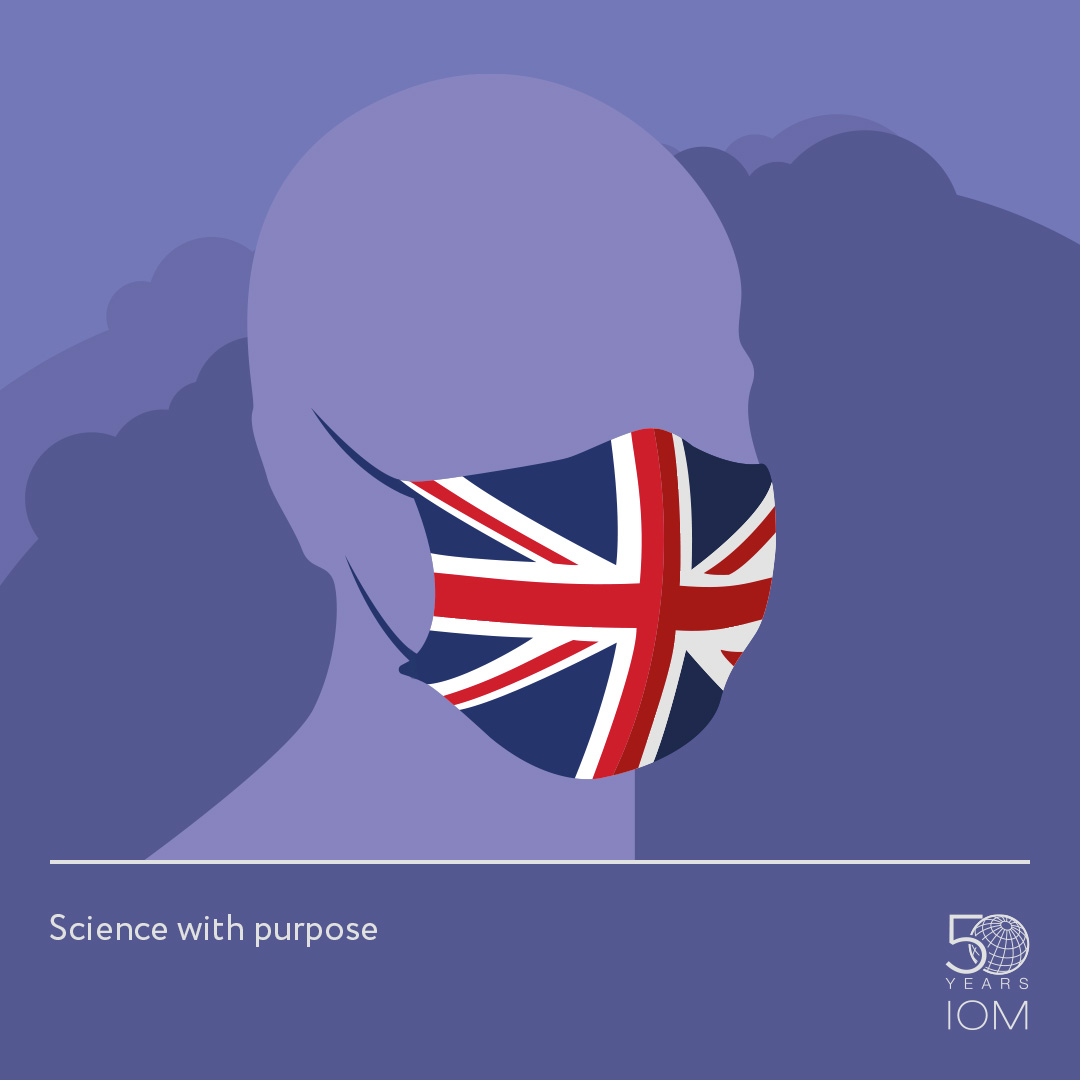
Managing occupational and environmental health risks in 2020, a science based approach
Covid-19


Covid-19

By Dr Rob Aitken, CEO, IOM – 23 July 2020
At the beginning of the second half of the year, it feels like the right time to take stock, and consider this extraordinary year so far. As IOM’s 50th celebrations came to a climax at the end of 2019 I could scarcely have believed where we are now.
When New Year rolled around so too did news from China of a highly transmittable airborne virus. We waited, knowing that it would be arriving but not fully grasping the severity of changes which would be imposed on us all and our everyday lives.
At the beginning of March, Coronavirus Disease (Covid-19) had spread to 76 countries with over 93,000 cases. The fatality rate was being recorded as high as 3.4% and although most cases people had experienced, mild systems it was becoming clear that it would cause global disruption.
Amidst the disruption, as we considered the implications for our own business, our teams of occupational hygienists, ventilation engineers, ergonomists, analysts and research scientists took action to join the fight against the virus. They began to deliver a programme of work to understand and manage the risks posed to workers, our customers and the wider public. In addition, we have engaged with a wide number of organisations to ensure that proper scientific argument is used to develop guidance and policy in this critical task.
In this blog, I will share some of this work with you and encourage you to make use of the materials we have developed to support you. Truly, managing occupational health risks has never been more vital than it is now.
Understanding COVID-19 exposure routes
IOM’s experience in occupational hygiene and health offers considerable scientific expertise relevant to understanding exposure routes, pathways, and the potential drivers of transmission and how these risks can be mitigated. Our teams manage the control of substances hazardous to health every day, mostly from dusts and chemical exposures; however, this framework also enables us to identify exposure risks and implement control measures to help minimize exposure and spread of infectious disease.
In the Spring, most official advice suggested that the virus was spread by large droplets (from coughs and sneezes) and surface contact. The role of respirable aerosol transmission, (opposed to transmission by large droplets) was almost completely discounted by World Health Organisation (WHO), Public Health England (PHE) the HSE in the grounds of insufficient evidence. This had significant implications for control measures and strategies particularly in the Health Service including the use of Respiratory Protective Equipment (RPE) and ventilation design.
In April, we responded to this omission and wrote to the World Health Organisation (WHO) expressing our concerns and we published some of the evidence in two editorials ‘Covid-19: Protecting Worker Health’ and ‘Protecting healthcare workers from inhaled SARS-CoV-2 virus’.
Furthermore, to improve understanding of aerosol transmission IOM received funding from Scotland’s Chief Scientific Office (CSO) to quantify the importance of aerosol transmission and the effectiveness of controls in NHS scenarios. We expect to be able to share results from this important study in the autumn of this year.
Since then evidence has continued to mount to the extent that aerosol transmission is now recognised in the scientific community, and to some extent in policy, as a significant vector in the spread of the disease
Managing COVID-19 transmission and developing control strategies
The main control strategies recommended by NHS and others still largely discount the role of aerosol transmission. The question of whether there is a significant proportion of viral dose in the airborne has huge implications for selection of mitigation measures, both PPE and ventilation.
For example, in the NHS proper respiratory protection (respirators) is only provided for those involved in Aerosol Generation Procedures (AGPs). In all other NHS scenarios, surgical facemasks are recommended. These are primarily intended to prevent the wearer from spreading the disease. Type II surgical masks are also designed to provide the wearer with protection against large droplets, but not respiratory aerosols.
Technically, surgical masks are medical devices, not personal protective equipment. However, a study of inward leakage of surgical masks carried out by IOM does indicate that surgical masks do actually provide some limited protection against respiratory, so a potentially effective consideration to be made to protect workers.
We developed a small study looking into the re-use of respirators following decontamination ‘Covid-19: Experts question guidance to reuse PPE’. Our study showed RPE decontamination must be undertaken with caution. Even with a new respirator, there is no guarantee that the fit will be adequate, nor that the protection it confers remains the same across the time it is worn. Under current circumstances, we need to develop the best practice for decontamination and re-use, recognizing that it is impossible to re-test each decontaminated respirator.
Our facemask future – the ongoing debate
Towards the end of April, IOM was amongst the first organisations to publically recommend wider use of face coverings.
“IOM believes that everyone outside their homes should wear non-medical face coverings such as bicycle masks, snoods and similar coverings. This will reduce the chance of infection from coughs and sneezes, both directly between people, and indirectly from droplet contamination of surfaces. This advice is particularly important in busy public spaces such as supermarkets, shopping centres and on public transport, including taxis.”
There was significant pushback at a policy level, and from some professional organisations. Supply issues were certainly a factor in this, as was lack of understanding between the purpose and intended use of face coverings, facemasks and respirators.
An emerging issue was the use of out of date respirators, then the disposal of millions of out of date respirators, despite the (albeit limited) testing showing that they were functioning perfectly well. There is no physical reason why respirators would cease to function beyond their expiry date.
From 24 July, face coverings will be mandatory in shops and supermarkets joining earlier policy interventions on public transport (and in retail in Scotland). Face coverings are intended to protect others the widespread use now being required based on the developing understanding of the importance of transmission by droplets and aerosols (and of asymptomatic transmission).
IOM, in collaboration with the Society of Occupational Medicine (SOM), British Occupational Hygiene Society (BOHS) and the Chartered Institute for Ergonomics & Human Factors (CIEHF) have developed a downloadable and printable guide for employers and the public to help identify and understand the use of face coverings, facemasks and disposable respirators. The collective is urging people to share and print this poster so people understand the differences between face coverings, facemasks and respirators.
Our work with the Nightingale Hospitals
Our Hygiene and Ventilation teams have been working with the NHS thought this crisis to help them bring more capacity on-stream to deal with the surge in demand. Our expert IOM Authorising Engineer services have been provided for the ventilation systems within the NHS Louisa Jordan field hospital. Our team adapted the exhibition centre halls into a fully functional field hospital. The work required the alteration of existing ventilation and new systems to provide suitable ventilation for the care of patients.
Turning an exhibition centre from a conference facility into a fully functional, clean and safe hospital was challenging but the effort has been satisfying and we feel privileged to be able to offer services on such a vital project.
Proud to be offering science-led expert opinion
IOM expert advice and opinion have been well sought after during this public health crisis, the scientific community and health body community are coming together to collaborate and provide outstanding advice and recommendations.
As we all begin to return to our workplaces, many employers and employees are concerned about preventing infection at work. IOM’s association with the Charter Institute of Ergonomics and Human Factors (CIEHF) is longstanding and we were pleased to work with them to develop their ‘Creating a safe workplace during COVID-19’ guide. This helps leaders and managers in businesses and organisations make their office workspaces safe for staff returning to work and reduce the transmission of the COVID-19 virus.
Dentistry is one area that has been facing new challenges and many practices are struggling to manage with new regulations. Dentists are postponing elective procedures and reducing office hours, the number of dental patients being treated is low and dentists are starting to feel the tremendous long-term impact of the pandemic on their businesses.
As a result, we received numerous enquiries from Dentists and following that a new we were happy to collaborate with the British Dental Association (BDA) on their COVID-19 guidance tool kit for Dentists across the UK.
Our contribution covered and shed light on RPE training & fit-testing programs. Ross Clark our Head of Workplace Protection also hosted a webinar discussing the use of respirators in dentistry, over 700 BDA members watch the live webinar. We also received a large volume of questions from Dentists and have provided a FAQ blog ‘The most common questions dentists are asking about respirators’.
Finally,
I’m proud with of the contribution that IOM has made thus far to combat this disease. Our work has challenged assumptions, improved scientific understanding, supported policy development and provided guidance and support across many sectors and for many people. It has shown the importance of science and the application of science with a purpose. As we emerge from this we must not lose sight of the lessons learned, about the importance of public health, and of science and of doing things right.
But this challenge is not over. According to WHO the UK had 294,792 cases and 45,300 deaths. These are devastating numbers and there is much more to be done to get this under control.
I recently read the following ‘Only if we end the pandemic everywhere can we end the pandemic anywhere. The entire world has the same goal: cases of COVID-19 need to go to zero.’ I hope we can all play a role to achieve that.